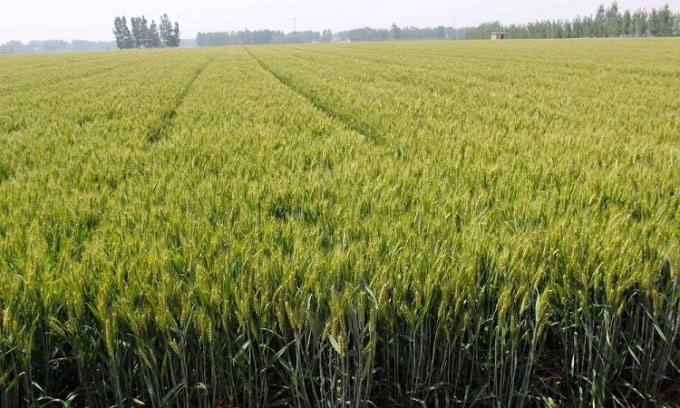China created mutant tree in space
At first glance, the wheat fields in northeastern China resemble any other wheat fields around the world. But it's no ordinary plant that was created in space. They are the Luyuan 502 wheat variety, the second most grown in China. Rice plants grown from seeds are sent to orbit at an altitude of 340 km above the Earth's surface.

Luyuan 502 is the second most cultivated wheat variety in China.
The Luyuan 502 variety yields 11% more than standard wheat grown in China, is drought tolerant and is more resistant to most common wheat pests and diseases, according to the National Energy Agency. International Atomic Energy Agency (IAEA). The IAEA is the coordinating body for international cooperation in the use of radiation-based techniques to create new varieties.
In addition to wheat, Chinese scientists also produce rice, corn, soybeans, alfalfa, sesame, cotton, watermelon, tomatoes, sweet peppers and many other vegetables.
China has been experimenting with mutagenicity in space since 1987 and is the only country in the world that has continuously applied this technique. They have conducted dozens of missions to put plant seeds into orbit. Chinese scientists announced the first space-breeding plant was a sweet chili named Yujiao 1 in 1990. Compared to traditional sweet pepper varieties, Yujiao 1 produces much larger fruit and is disease resistant. than.
In 2006, China sent into orbit the largest amount of seeds, including 250 kg of seeds and microbial organizations of 152 species on the satellite Shijian 8. In May this year, 12,000 seeds belonging to several species of grass and oats. , alfalfa and mushrooms were brought back to Earth on the Shenzhou 13 mission. They even launched a batch of rice during their trip around the Moon with the Chang'e 5 mission in November 2020. According to reports, these grains have successfully grown in the laboratory after being brought back to Earth.
Seeds are usually sent into space in flights lasting from four days to several months. In the unusual environment of the universe, a number of changes can occur to seeds and plants. First, high solar energy and cosmic radiation can destroy the plant material in the seed, leading to mutations or chromosomal abnormalities that are passed on to future generations. Low gravity environments can also lead to other changes. Plants that germinate and grow under microgravity often exhibit changes in cell shape and structural organization within cells.
In most cases, Chinese scientists send seeds into space, then plant them on the ground. Young plants are screened for useful properties that give them an advantage over conventional cultivars. Researchers are often looking for changes that result in large fruit, low irrigation requirements, good nutritional value, high and low temperature tolerance, or strong disease resistance. In some cases, rare mutations can lead to breakthroughs in crop yield. The most promising crops were further bred until the researchers obtained improved varieties that met the needs of the farmers.
Both space and radiation mutagenesis techniques can cut the development time of new varieties in half, according to Shoba Sivasankar, who directs the IAEA's Plant Breeding and Genetics organization and Food and Agriculture Organization of the United Nations (FAO). Through two methods, China has developed and put into production more than 800 new varieties, improving all important characteristics compared to conventional crops, according to the IAEA.
Liu Luxiang, an expert on China's space mutagenesis technique and director of the Space Mutagenic Center for Crop Improvement, Institute of Crop Science of the Academy of Agricultural Sciences in Beijing. It is more expensive to send seeds into space than to place them in a radiation projector on the ground. However, space flight offers clear benefits and often gives better results. In a radiation projector, the seeds receive a large amount of ionization from 50 to 400 gray in a few seconds. On the other hand, the seed during the week-long flight into space was exposed to only 2 milligrams. As a result, 50% of the seeds could not germinate after irradiation while almost all the seeds put into space could grow into plants.
- Greenhouses grow mutant seeds in space
- Why are there species of plants that live more than 1,000 years?
- How to mutate Delta, Kappa strains to overcome Covid-19 vaccine
- Successfully creating mutant worms drinking alcohol without being drunk
- The red pine tree has become
- China speeds up space
- China creates cosmic black holes
- By 2022, China will have the first international space station
- The oldest tree in England has changed sex after 3,000 years
- Demonstration mutant shrinks the body to wear a 3-year-old shirt
- The 300 year old hollow tree still lives healthy
- China: Buddha's head is revealed from a 1,000-year-old tree trunk
 Why do potatoes have eyes?
Why do potatoes have eyes? 'Tragedy' the world's largest carnivorous life: Death becomes ... public toilet
'Tragedy' the world's largest carnivorous life: Death becomes ... public toilet Tomatoes were once considered 'poisonous' for 200 years
Tomatoes were once considered 'poisonous' for 200 years Detecting microscopic parasites on human face
Detecting microscopic parasites on human face